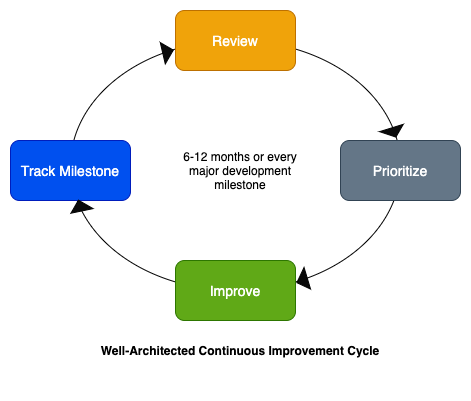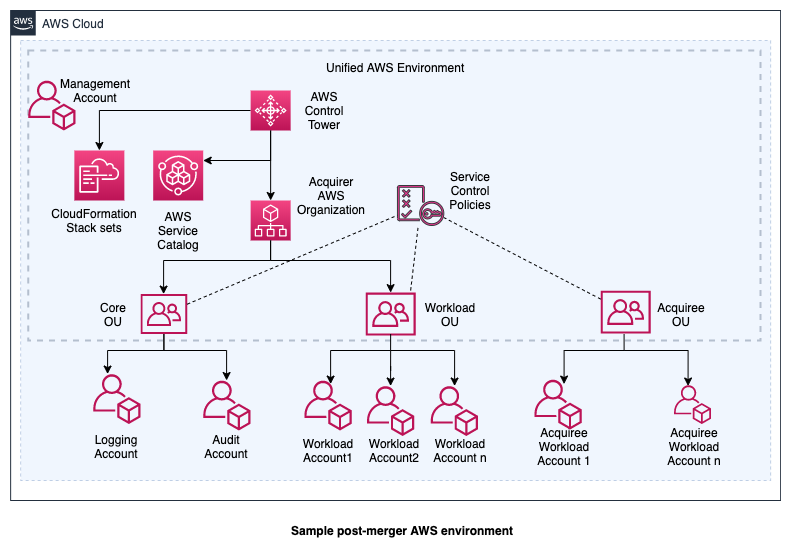AWS Architecture Blog
Mergers and Acquisitions Readiness with the Well-Architected Framework
Companies looking for an acquisition or a successful exit through a merger, undergo a technical assessment as part of the due diligence process. While being a profitable business by itself can attract interest, running a disciplined IT department within your organization can make the acquisition more valuable. As an entity operating cloud workloads on AWS, you can use the AWS Well-Architected Framework. This will demonstrate that your workloads are architected with industry best practices in mind. The Well-Architected Framework explains the pros and cons of decisions you make while building systems on AWS. It consistently measures architectures against best practices observed in customer workloads across several industries. These workloads have achieved continued success on AWS through architectures that are secure, high-performing, resilient, scalable, and efficient. The Well-Architected Framework evaluates your cloud workloads based on five pillars:
- Operational Excellence: The ability to support development and run workloads effectively, gain insights into your operations, and continuously improve supporting processes and procedures to deliver business value.
- Security: The ability to protect data, systems, and assets to take advantage of cloud technologies to improve your security.
- Reliability: The ability of the workload to perform its intended function correctly and consistently. This includes the ability to operate and test the workload through its complete lifecycle.
- Performance Efficiency: The ability to use computing resources efficiently to meet system requirements, and to maintain that efficiency as demand changes and technologies evolve.
- Cost Optimization: The ability to run cost-aware workloads that achieve business outcomes while minimizing costs.
The Well-Architected Framework Value Proposition in Mergers & Acquisitions (M&A)
Continuously assess the pre-M&A state of cloud workloads – The Well-Architected state for a workload must be treated as a moving target. New cloud patterns and best practices emerge every day. The Well-Architected Framework constantly evolves to incorporate them. Your workloads can continuously grow, shrink, become more complex, or simpler. Mergers and acquisitions can be a long, drawn-out process, which can take can take months to complete. Well-Architected reviews are recommended for workloads every 6 months to 1 year, or with every major development milestone. This helps guard against IT inertia and allows emerging best practices to be accounted for in your continuously evolving workload architecture. The technical currency can be maintained throughout the M&A process by continuously assessing your workloads against the Well-Architected Framework. The accompanying AWS Well-Architected Tool (AWS WA Tool) helps you track milestones as you make improvements to and measure your progress.

Standardize through a common framework – One of the biggest challenges in M&As is the standardization of the Enterprise IT post-merger. The IT departments of organizations can operate differently, and have vastly different IT assets, skill sets, and processes. According to a McKinsey article on the Strategic Value of IT in M&A, more than half the synergies available in a merger are related to IT. If the acquirer is also an AWS customer, this can enable the significant synergies in M&As. The Well-Architected Framework can be a foundation on which the two IT departments can find common ground. Even if the acquirer does not have a cloud-based environment like AWS, inheriting a Well-Architected AWS setup can help the post-merger IT landscape evolve.
Integrate seamlessly through Well-Architected landing zones – AWS Control Tower service or AWS Landing Zone solution are options that can provision Well-Architected multi-account AWS environments. Together with AWS Organizations, this makes the IT integration a lot smoother for the AWS environments across enterprises. AWS accounts can detach from one AWS Organization and attach to another seamlessly. The latter can enroll with an existing Control Tower setup to benefit from the security and governance guardrails. In a Well-Architected landing zone, your management account will not have any workloads. As shown in the following diagram, you may move member accounts from your AWS Organization to your acquirer’s AWS Organization under the right Organizational Unit (OU). You can later decommission your AWS Organization and close your management AWS account.


Benefit from faster migration to AWS – using the Well-Architected Framework, you can achieve faster migration to AWS. Workload risks can be mitigated beforehand by using best practices from AWS before the migration. Post migration, the workloads benefit from AWS offerings that already have many of the Well-Architected best practices built into them. The improvement plans from the Well-Architected tool include the recommended AWS services that can address identified risks. Physical IT assets are heavily depreciated during an acquisition and do not fetch valuations close to their original purchase price. AWS workloads that are Well-Architected should be evaluated by the actual business value they provide. By consolidating your IT needs on AWS, you are also decreasing the overhead of vendor consolidation for the acquirer. This can be challenging when multiple active contracts must transfer hands.
Overcome the innovation barrier – At the onset of an M&A, companies may be focusing too much on keeping the lights on through the process. Businesses that do not move forward may fall behind on continuous innovation. Not only can innovation open more business opportunities, but it can also influence the acquisition valuation. Well-Architected reviews can optimize costs. This can result in diverse benefits such as better agility and an increased use of advanced technologies. This can facilitate rapid innovation. Improvements gained in the security posture, reliability, and performance of the workload make it more valuable to the acquirer.
Demonstrate depth in your area of expertise – Well-Architected lenses help evaluate workloads for specific technology or business domains. Lenses dive deeper into the domain-specific best practices for the workload. If your business specializes in a domain for which a Well-Architected lens is available, doing a review with the specific lens will provide more value for your workload. Today, AWS has lenses for serverless, SaaS, High Performance Computing (HPC), the financial services industry, machine learning, IoT workloads and more. We recently announced a new Management and Governance Lens.
Build workloads using AWS vetted constructs – AWS Solutions Library provides you a repository of Well-Architected solutions across a range of technologies and industry verticals. The library includes reference architectures, implementations of reusable patterns, and fully baked end-to-end solution implementations. Use these building blocks to assemble your workloads. Include the AWS recommended best practices into them, and create an attractive proposition to an acquirer.
Conclusion
You can start taking advantage of the Well-Architected Framework today to improve your technical readiness for an acquisition. The Well-Architected Tool in the AWS Management Console allows you to review your workload at no cost. Engage with your AWS account team early, and we can provide the right guidance for your specific M&A, and plan your Well-Architected technical readiness. Using the Well-Architected Framework as the cornerstone, the AWS Solutions Architects and APN partners have guided thousands of customers through this journey. We are looking forward to helping you succeed.